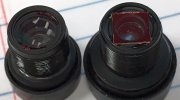Some random info on IP cameras- the ones I've pulled apart use a mechanically operated IR filter that is fitted in between the lens and sensor. It can be moved in or out to allow for the cameras to operate using IR light at night. Some of the lenses specify if they have IR correction, I believe that's to do with the focal point difference between sunlight and the artificial IR light? Dashmellow- you'd probably know more about that??
You bring up an interesting point, although one which is probably more of concern to CCTV cameras with IR cut filters and IR emitters than for us dash cam guys experimenting with aftermarket lenses and IR-cut filters to install. As long as we focus manually for the lens with or without an IR cut filter, things will be in proper focus. Anyway, since you bring it up, I'll talk about it and hope everybody finds it at least somewhat interesting, especially since we're talking about IR cut filters on "IR" CCTV lenses.
On CCTV cameras there is a common problem with focus shift between daylight and at night under artificial IR illumination where images that are sharp and in focus under IR artificial lighting are out of focus in daylight conditions and vice versa. This is because different wavelengths of light have different points of focus on the film plane. In this instance, when infrared wavelengths are in focus, daylight wavelengths are not, as in the example below.
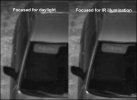
There are different methods of dealing with this. Some CCTV cameras deal with this in firmware or with specialized corrected lenses or with remote focus lenses that change for the given conditions or some other mechanical technique.
You'll notice that many of these aftermarket lenses we have been talking about are specifically designated "IR" and that means more than just not having an IR-cut filter installed. Often they are specifically designed to optimize focus of IR wavelengths accurately on the sensor plane.
Note that the lens specifically says, "IR". It could easily just not come with an IR-cut filter on it without having to mention "IR".
I'm not sure all these lenses we see that say IR are really IR but some of them do have the correction built in.
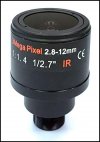
Some of you might have noticed red markings on camera lenses you might use on your DSLR cameras and wondered what those extra markings are for. Those markings are meant to allow IR focus compensation for shooting on IR film or modified digital cameras and it's the same IR focus shift thing that happens with CCTV cameras. It's why they are red, of course.
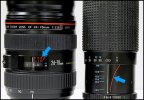
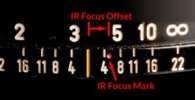
Anyway, I've talked about this subject previously and demonstrated it in my Mobius Varifocal IR lens thread
in the post where I filmed the foxes at night under IR illumination.
I'll quote what I said in that thread below and post a screen shot for convenience but anyone who wants can go and view the two videos and you'll see that the first one is slightly out of focus and the second one was re-focused for shooting under IR lighting.
"In this video I left the camera exactly as I've had it focused when I use the varifocal lens in my vehicle. In my truck for example, objects within 10 to 20 feet are in tack sharp focus as seen in many of the screen shots in this thread but here with the focus set for daylight the same the video is not quite as focused as it might have been. This is a common issue with IR video and photography because infra-red light wavelengths focus on a different plane on the sensor (slightly in front of or behind) thereby causing a focus shift. IR Focus Shift is the condition that occurs when images that are sharp and in focus under in daylight conditions are out of focus under artificial IR illumination lighting at night and vice versa. In the second video I've corrected the focus for IR and optimized for a close shot."

I recently posted a picture of one such assembly in an adjacent thread:
https://dashcamtalk.com/forum/threads/mobius-varifocal-zoom-ir.30602/page-8
I am planning to salvage the IR filter and use UV cured epoxy to mount it in my F1.2 lens. I have some Loctite 352 at work I can "borrow" a few drops and cure it with my Nitecore CU6 UV light which claims 3000 mA UV emitor @365 nm.
@Radius8, you mentioned that there is an extra filter installed in the IR-cut mechanism you purchased.I've been wondering about that and it is "possible" that this extra filter (which would be inserted into the light path during the day from the looks of your photo) is designed to compensate for the IR focus shift I've been talking about here, but I'm not sure; just speculating.
Also, Loctite 352 seems like it could be a good candidate for mounting IR-cut filters. I see that it is amber in color though and optical cements are clear. Not sure if it matters though.
Here's an article that talks about focus shift in relation to IR corrected lenses.
https://www.cctv-information.co.uk/i/Resolving_the_Problem_of_Focus_Shift





